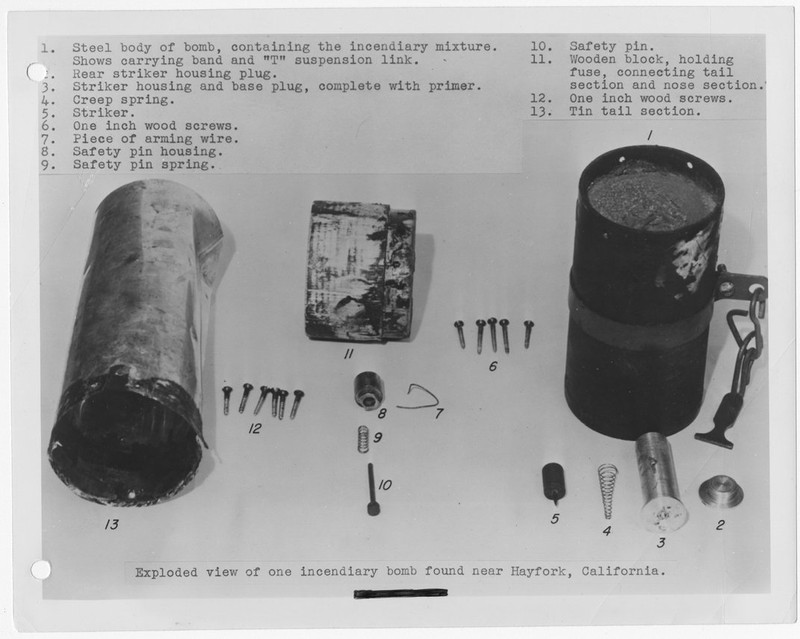Japanese Bomb Balloon Historical Marker
Introduction
Text-to-speech Audio
Dedicated in 1978 at the Trinity County Fairgrounds, this marker shares a relatively unknown chapter in World War II's history. In the final months of the war, the Japanese military released small bombs supported by balloons into the jet stream with the goal of attacking the United States. One of these bombs landed two-and-a-half miles from the marker where it caused minor damage and no loss of life. Numerous Japanese balloon bombs made it to the United States, but the damage was minimal and the War Department minimized news coverage. Japan had hoped to demonstrate that even as American forces controlled more of the Pacific and were able to attack Japanese cities, American communities were not completely safe. Japan launched thousands of bombs into the jetstream hoping to cause substantial damage, including starting forest fires. The U.S. military worked to prevent news coverage of the bombs that reached the U.S., correctly recognizing that these news reports would encourage the Japanese military to launch more ballons. The strategy worked and Japan decided to give up on the attacks. However, the strategy of silence also meant that a family in Oregon enjoying a picnic in 1945 did not know that the balloon they encountered was dangerous. While the balloon mentioned in this marker caused no injuries, five children and a pregnant woman were killed by the bomb in Oregon.
Images
Information about the attack in Oregon from Smithsonian

This historical marker was dedicated in 1978

Backstory and Context
Text-to-speech Audio
This historical marker serves as a reminder that Pearl Harbor was not the only time the Japanese bombed American soil. From the year 1944 through the year 1945 Japan launched over 9,000 balloon bombs, however, only around 300 ever reached the United States, and there is only one known incident where the bombs caused physical harm to a person.
The Fu-Go, better known as the firebomb or balloon bomb, was a weapon intended to be cheaply made using the jet stream to carry explosives to the United States. In some ways, these balloon bombs could be considered a predecessor to the intercontinental ballistic missiles that would later be developed. While the balloon bombs were not very effective in causing damage because most sailed off-target, landed in the ocean, failed to explode, or landed in remote locations, the attempt demonstrates that both the United States and Japan were willing to try nearly any strategy to attack the homeland of the other. Bombs are known to have arrived from Alaska to California, Kansas, and even as far south as Texas.
The one incident that resulted in casualties occurred on May 5, 1945, in Bly, Oregon. Reverend Archie Mitchell, his pregnant wife Elsie, were in charge of Sunday school and took themselves and a few children outdoors to enjoy a picnic. While Reverend Archie set up the picnic, the wife played with the children in the area and they stumbled upon a large white tarp in the woods. Elsie called out to her husband to get his attention, and before he could tell them they were in danger, one of the children touched the balloon causing it to explode. Tragically, the bomb killed the pregnant woman and five children. Prior to this deadly event, the United States government acknowledged that Japan was attempting to send bombs via ballons in the jet stream. Prior to that event, military and civilian leaders believed it would be better for moral to not acknowledge the bombing campaign.
Sources
Barry Swackhamer. Japanese Bomb Balloon, Historical Marker Database. Accessed November 26th 2021. https://www.hmdb.org/m.asp?m=112565.
Uenuma, Francine. In 1945, a Japanese Balloon Bomb Killed Six Americans, Five of Them Children, in Oregon, Smithsonian Magazine. May 19th 2019. Accessed November 26th 2021. https://www.smithsonianmag.com/history/1945-japanese-balloon-bomb-killed-six-americansfive-them-children-oregon-180972259/.
Rizzo, Johnna. Japan's Secret WWII Weapon: Balloon Bombs, National Geographic . May 27th 2013. Accessed November 26th 2021. https://www.nationalgeographic.com/science/article/130527-map-video-balloon-bomb-wwii-japanese-air-current-jet-stream.
https://www.smithsonianmag.com/history/1945-japanese-balloon-bomb-killed-six-americansfive-them-children-oregon-180972259/
https://www.hmdb.org/PhotoFullSize.asp?PhotoID=206269
